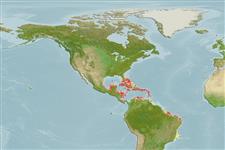Environment: milieu / climate zone / depth range / distribution range
Ecología
marino asociado a arrecife; rango de profundidad 0 - 5 m (Ref. 9710). Tropical; 32°N -
Western Atlantic: Bermuda, southern Florida (USA), and Bahamas to Lesser Antilles and Central America (and probably northern South America). Antilles, Yucatan, Belize to Nicaragua (Ref. 26938).
Tamaño / Peso / Age
Maturity: Lm ? range ? - ? cm
Max length : 9.0 cm TL macho / no sexado; (Ref. 7251)
Short description
Morfología | Morfometría
Espinas dorsales (total): 19 - 21; Radios blandos dorsales (total): 10-12; Espinas anales 2; Radios blandos anales: 19 - 21. Brown with 5 irregular dark brown bars on body, the anterior 3 of which extend basally into dorsal fin; no black spot on opercle; two dark brown dots or short lines posterior to eye; females with numerous dark dots in fins (Ref. 13442).
Occurs from rocky and rubble shores with algal mats to reefs and seagrass beds.
Life cycle and mating behavior
Madurez | Reproducción | Puesta | Huevos | Fecundidad | Larva
Robins, C.R. and G.C. Ray, 1986. A field guide to Atlantic coast fishes of North America. Houghton Mifflin Company, Boston, U.S.A. 354 p. (Ref. 7251)
IUCN Red List Status (Ref. 130435)
Threat to humans
Harmless
Human uses
Acuario: Comercial
Más información
Nombres comunesSinónimosMetabolismoDespredadoresEcotoxicologíaReproducciónMadurezPuestaAgregación para la puestaFecundidadHuevosEgg development
Age/SizeCrecimientoLength-weightLength-lengthLength-frequenciesMorfometríaMorfologíaLarvaDinámica larvariaReclutamientoAbundanciaBRUVS
ReferenciasAcuiculturaPerfil de acuiculturaRazasGenéticaElectrophoresesheritabilidadEnfermedadesProcesamientoNutrientsMass conversion
Herramientas
Special reports
Download XML
Fuentes de Internet
Estimates based on models
Preferred temperature (Ref.
123201): 26.6 - 28.2, mean 27.5 °C (based on 516 cells).
Phylogenetic diversity index (Ref.
82804): PD
50 = 0.5078 [Uniqueness, from 0.5 = low to 2.0 = high].
Bayesian length-weight: a=0.00490 (0.00196 - 0.01224), b=3.09 (2.87 - 3.31), in cm total length, based on LWR estimates for this (Sub)family-body shape (Ref.
93245).
Nivel trófico (Ref.
69278): 3.8 ±0.6 se; based on size and trophs of closest relatives
Fishing Vulnerability (Ref.
59153): Low vulnerability (10 of 100).
Nutrients (Ref.
124155): Calcium = 146 [72, 247] mg/100g; Iron = 0.751 [0.407, 1.304] mg/100g; Protein = 18.4 [17.3, 19.5] %; Omega3 = 0.0884 [, ] g/100g; Selenium = 17.1 [7.0, 39.9] μg/100g; VitaminA = 185 [56, 610] μg/100g; Zinc = 2.16 [1.37, 3.18] mg/100g (wet weight);
